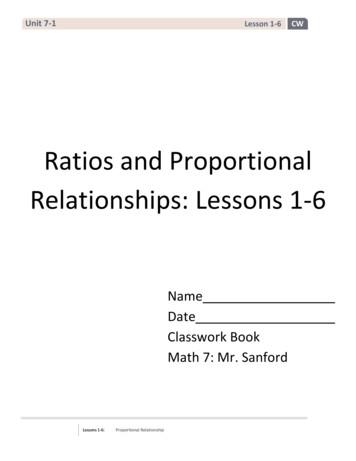Lesson 8: Identifying Proportional And Non-Proportional .
Name:Accordino-Math 7M1L8Date:Period:Lesson 8: Identifying Proportional andNon-Proportional Relationships in Graphs(Graph to Table)Bellringer1) What are the cooridinates for point E?a.b.c.d. 5,2 2,5 0,6 2,8 2) Sam paid 8.28 for 18 stamps. At this rate, how much would it cost Sam to buy 12 stamps?
Name:M1L8Accordino-Math 7Date:Period:Lesson 8: Identifying Proportional and NonProportional Relationships in Graphs (Tables toGraphs)Exit Ticket(2 points) For each of the graphs below state whether they represent a proportional relationship and how you know. Ifthe graph does represent a proportional relationship find the unit rate.Proportional Relationship? Yes/NoHow do you know?Proportional Relationship? Yes/NoHow do you know?
Name:M1L8Accordino-Math 7Date:Period:Lesson 8: Identifying Proportional and Non-ProportionalRelationships in Graphs (Graph to Table)ClassworkREVIEW:Characteristics of graphs of proportional relationships:We can also conclude if a set of values are in a proportional relationship by looking at the graph of the ordered pairs!Example 1:The graph below represents the relationship of height above the ground to time for a hotair balloon.Time(in hours)Height aboveground (inmiles)122.534What is the unit rate? Plot it on the graph.Does the graph represent a proportional relationship?If Grandma Agnus wants to take a two and half hour balloon ride, how high above the ground should she expect to be?
Name:M1L8Accordino-Math 7Date:Period:Example 2The graph below represents the relationship of number of song downloaded to number of visits to the iTunes store.# of Web Visits# of downloadsWhat is the unit rate? Plot it on the graph.Does the graph represent a proportional relationship?If my child visits the iTunes store 60 times how many songs should I expect them to have downloaded?Example 3Samantha types an average of 50 words per minute. Which of the following graphs shows the relationship betweentotal number of words typed and time spent typing?Time (inminutes)Find the unit rate , create a table, then match the points to a graph.What is the unit rate?# of wordstyped
Name:M1L8Accordino-Math 7Date:Period:You Try!1) The graph below represents the relationship between distance from home and time in hours during a family road trip.Time (in hours)Distance fromhome (in miles)What is the unit rate? Plot it on the graph.Does the graph represent a proportional relationship?At this rate, if you have been in the car for 12.3 hours how many miles have you traveled?2) I want to bake 12 dozen cookies. If I can bake 2 dozen cookes in an hour how long with it take me to bake all twelvedozen cookies.a. What is my unit rate of dozen cookies per hour?b. Make a table and graph representing the relationship.
Name:M1L8Accordino-Math 7Date:Period:Homework:1) The table below represents a proportional relationship. What point on the graph represents theunit rate?a. (1 , 1)b. (1 , 2)c. (2 , 1)d. (2 , 4)2)Find the unit rate for each of the proportional relationships below.3) Grandma Antoinette can make 4 loaves of rubarb bread in 3 hours.a. Create a table showing the relationship between loaves of bread baked and hours spent baking.b. Graph the ordered pairs on the coordinate grid (label your axis).c. What point represents the unit rate?Time spentbaking (inhours)Loaves baked
Lesson 8: Identifying Proportional and Non-Proportional Relationships in Graphs (Tables to Graphs) Exit Ticket (2 points) For each of the graphs below state whether they represent a proportional relationship and how you know. If the graph does represent a proportional relationship find the unit rate.
Lesson 5: Identifying Proportional and Non-Proportional Relationships in Graphs Student Outcomes Students decide whether two quantities are proportional to each other by graphing on a coordinate plane and observing whether the graph is a straight line through the origin.
Lesson 3: Identifying Proportional and Non-Proportional Relationships in Tables Student Outcomes Students examine situations to decide whether two quantities are proportional to each other by checking for a constant multiple between measures of and measures of when given in a table.
4 Step Phonics Quiz Scores Step 1 Step 2 Step 3 Step 4 Lesson 1 Lesson 2 Lesson 3 Lesson 4 Lesson 5 Lesson 6 Lesson 7 Lesson 8 Lesson 9 Lesson 10 Lesson 11 Lesson 12 Lesson 13 Lesson 14 Lesson 15 . Zoo zoo Zoo zoo Yoyo yoyo Yoyo yoyo You you You you
Lesson 4: Identifying Proportional and Non-Proportional Relationships in Tables Classwork Example: Which Team Will Win the Race? You have decided to walk in a long-distance race. There are two teams that you can join. Team A walks at a constant rate of 2.5 miles per hour. Team B walks 4 miles the first hour and then 2 miles per hour after that.
G7-M1-Lesson 5: Identifying Proportional and Non-Proportional Relationships in Graphs Recognizing Proportional Graphs Determine whether or not the following graphs represent two quantities that are proportional to each other. Explain your reasoning. 1. The graph shows that distance in miles is proportional to the time in hours because the points
Identifying Proportional and Non-Proportional Relationships in Graphs (E) In Lesson 1 of Topic A, students are reintroduced to the meanings of value of a ratio, equivalent ratios, rate, and unit rate through a collaborative work task where they record their rates choosing an appropriate unit of
Grade 7 Lesson 1 -5: Identifying Proportional Relationships in Graphs 13 Lesson 6: Identifying Proportional Relationships in Graphs and Tables . Today’s activity is an extension of Lesson 5. You will be working in groups to table, graph and identify whether or not the two
influence of ideological values on the policies and practices of America’s criminal justice systems. Recently, however, a trend toward critical analysis of the behavior of police, courts, and corrections has emerged that focuses exclusively on ideology as the analytical tool of choice. For example, Barlow (2000), and Bohm and Haley (2001) include extensive discussion of the influence of .























